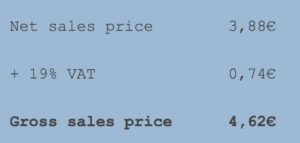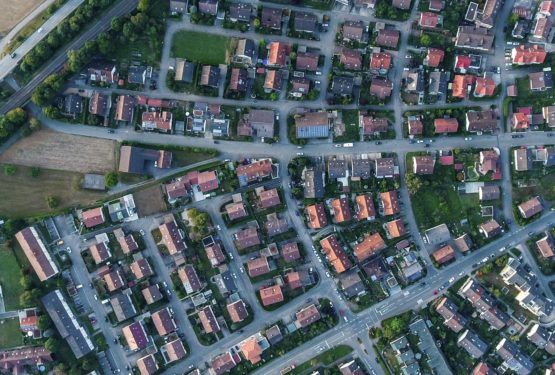
Calculating the prices of your street food dishes correctly is an important but not so easy task. After all, the price calculation affects your existence and is crucial to how much profit you make.
The prices of your food have a big influence on the success of your food truck. Small errors in the calculation can add up to large sums over time and affect the financial situation of your business. We will now show you how to calculate the pricing of your food truck business.
The selling price of your street food creations: 5 important components
When calculating the price of your food, on the one hand you take into account the cost of your food, but on the other hand, you consider the costs that are incurred in your business and which you would like to compensate with your sales prices. Basically, you should be able to cover all your costs with the sale of your foods and drinks and make a profit that corresponds to your cost of living.
This is how your selling price is made up:
Cost of goods: To calculate your prices, you should first determine your recipes and the exact portion sizes for each of your creations. This way you can calculate exactly how much a portion costs, i.e. what the purchase price is for the ingredients you use.
Overhead costs (electricity, stand rent etc.): When calculating prices, consider all the costs you have to bear as a food truck owner. These include, for example, your stand rental costs and incidental costs for delivery and transport, as well as the costs for storage and quality control of your food, your electricity, gas, water, internet and insurance bills and also the costs incurred for marketing activities.
Staff costs: If you do not work alone but have employees, you should consider your staff costs in the price calculation, which include all wages and non-wage labour costs, such as social security contributions.
Turnover and value added tax: You should also take into account the turnover and value added tax you have to pay in your street food price calculation. A tax rate of 7% usually applies to standing snacks and food trailers. Note that a tax rate of 19% applies if you offer seating.
Profit margin: Once you have added up all the occurring costs, you will receive the amount you should cover with the income from your foods and drinks. What you add to that amount is the profit, or margin. How much the profit is depends on the individual. If there is a high demand for your street food creations, you can set the profit higher.

The 3 step pricing method
Now we will show you a calculation method with which you can calculate your sales prices quickly and easily. With this method, the raw costs of your goods are given a markup.
The price calculation formula:
1. Basic price: cost of goods + 40% for maintenance + 30% overhead costs + 20-40% calculated profit
2. Net sales price: basic price + 17–20% staff costs
3. Gross total price:net sales price + 19% VAT
The basis of your calculation: The costs for a dish
You determine the raw costs per dish by developing your recipes and calculating the portion prices based on these. The portion prices refer to the cost of a portion in the purchase.
In our example we sell home-made Swabian cheese noodles:

How to calculate the basic price
To calculate the basic price of your dish, add 40% for maintenance, 30% for overhead costs and 20-40% for profit to your raw costs.

How to calculate the net sales price
To calculate the net sales price, add 17–20% to your basic price for your staff costs.

How to calculate the gross sales price
To your net sales price you now add 7 or 19% VAT and you get your gross sales price, i.e. the price you write on your menu.

Once you have determined your sales price, you can still adjust it from a sales-psychological view. If your calculated price results in a fractional value (4,62€), as in our example, it is better to round it up. For example to 4,90€. That looks much more attractive.
If you are calculating sales prices for food that you offer at large events such as street food festivals, take into account the much greater organisational effort required for planning and the additional costs that you have to bear. For example, the high stand rental fees, the use of refrigerated containers, additional staff or the supply of dishes.
These factors influence the selling price
As I said, price calculation is an important task – and perhaps not an easy one either. There are a number of additional factors that you should consider when setting your sales prices:
Purchase price: The purchase price of your food depends on the type of food and the quantity purchased. Good negotiating skills are also crucial for pricing.
Quality: The quality of the food you buy plays an important role for your personal demands, but is also a decisive factor in determining the clientele you want to address and the price structure (cheap, medium or high price) in which you want to offer your street food creations.
Recipe: The composition of your dishes has an immense importance for your price calculation. Some companies do not have fixed recipes, but this means that it is easy to hide or forget expensive cost components.
Portion size: It is important that you define the portion size of your food and check it regularly during preparation. Always keep an eye on your quantities. If you prepare portions that are too large, you will make losses. If you offer smaller portions, you can save costs. However, always make sure that the portion size and the price match. In order to optimise your price calculation, you can adapt your dishes to the season, which not only saves money, but also adds a certain variety to your menu.
Losses: Losses can occur during the preparation and cooking of your food. Peeling and cutting, or if, for example, the liquid in the vegetables evaporates during frying.This will result in weight loss and thus in a difference between the quantities bought and sold. This in turn has an impact on the selling price.
Your competitors and the market situation: Analyse your competitors in pricing and find out which products they offer at what price. Also be careful not to be too optimistic about the demand for your products. If you assume a high demand, you will buy more food. If you don’t sell the planned quantities, you won’t be able to cover your calculated income and therefore your expenses. To estimate the actual demand for your price calculation, you can analyse industry reports.
Conclusion: Your success and failure as a food truck owner depends on a good price calculation
The price calculation can make the difference between success and failure for your mobile kitchen business. Don’t just determine your price with simple factors, but also consider important factors such as the purchase price, the quality and recipe of your street food dishes as well as your competitors and the market situation.
When starting your Street Food Business it is important that you take care of the price calculation at an early stage. This way you can create a first version of your menu and better estimate your food truck sales, which in turn is an important point in your financial plan for your business plan.




